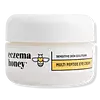What's inside
What's inside
 Key Ingredients
Key Ingredients

 Benefits
Benefits

 Concerns
Concerns

 Ingredients Side-by-side
Ingredients Side-by-side

Water
Skin ConditioningGlycerin
HumectantCaprylic/Capric Triglyceride
MaskingC12-15 Alkyl Benzoate
AntimicrobialCoconut Alkanes
EmollientAloe Barbadensis Leaf Juice
Skin ConditioningCetearyl Olivate
Sorbitan Olivate
EmulsifyingGlyceryl Stearates
EmollientAvena Sativa Kernel Flour
AbrasivePrunus Amygdalus Dulcis Oil
Skin ConditioningCetyl Alcohol
EmollientRosa Moschata Seed Oil
EmollientPersea Gratissima Oil
Skin ConditioningHoney
HumectantHydroxyapatite
AbrasiveXanthan Gum
EmulsifyingSodium Acrylates Copolymer
Lecithin
EmollientCetyl Palmitate
EmollientSorbitan Palmitate
EmulsifyingButyrospermum Parkii Nut Extract
EmollientPyrus Malus Fruit Extract
Skin ConditioningCoco-Caprylate/Caprate
EmollientEthylhexylglycerin
Skin ConditioningDipeptide Diaminobutyroyl Benzylamide Diacetate
Skin ConditioningHydroxypropyl Cyclodextrin
MaskingPalmitoyl Tripeptide-38
Skin ConditioningPalmitoyl Tripeptide-1
Skin ConditioningPalmitoyl Tetrapeptide-7
Skin ConditioningPalmitoyl Tripeptide-5
Skin ConditioningSteareth-20
CleansingN-Hydroxysuccinimide
Skin ConditioningChrysin
Skin ConditioningEscin
TonicCitric Acid
BufferingSodium Citrate
BufferingBenzoic Acid
MaskingTocopherol
AntioxidantPhenoxyethanol
PreservativeChlorhexidine Digluconate
AntimicrobialPotassium Sorbate
PreservativeBiotin
AntiseborrhoeicWater, Glycerin, Caprylic/Capric Triglyceride, C12-15 Alkyl Benzoate, Coconut Alkanes, Aloe Barbadensis Leaf Juice, Cetearyl Olivate, Sorbitan Olivate, Glyceryl Stearates, Avena Sativa Kernel Flour, Prunus Amygdalus Dulcis Oil, Cetyl Alcohol, Rosa Moschata Seed Oil, Persea Gratissima Oil, Honey, Hydroxyapatite, Xanthan Gum, Sodium Acrylates Copolymer, Lecithin, Cetyl Palmitate, Sorbitan Palmitate, Butyrospermum Parkii Nut Extract, Pyrus Malus Fruit Extract, Coco-Caprylate/Caprate, Ethylhexylglycerin, Dipeptide Diaminobutyroyl Benzylamide Diacetate, Hydroxypropyl Cyclodextrin, Palmitoyl Tripeptide-38, Palmitoyl Tripeptide-1, Palmitoyl Tetrapeptide-7, Palmitoyl Tripeptide-5, Steareth-20, N-Hydroxysuccinimide, Chrysin, Escin, Citric Acid, Sodium Citrate, Benzoic Acid, Tocopherol, Phenoxyethanol, Chlorhexidine Digluconate, Potassium Sorbate, Biotin
Water
Skin ConditioningHydrogenated Polyisobutene
EmollientDimethicone
EmollientGlycerin
HumectantButyrospermum Parkii Butter
Skin ConditioningPanthenol
Skin ConditioningZea Mays Starch
AbsorbentPropanediol
SolventButylene Glycol
HumectantCetyl PEG/PPG-10/1 Dimethicone
EmulsifyingTrihydroxystearin
Skin ConditioningCentella Asiatica Leaf Extract
Skin ConditioningPolymnia Sonchifolia Root Juice
Skin ConditioningZinc Gluconate
Skin ConditioningMadecassoside
AntioxidantManganese Gluconate
Skin ConditioningAlpha-Glucan Oligosaccharide
CleansingSilica
AbrasiveAluminum Hydroxide
EmollientMagnesium Sulfate
Mannose
HumectantCapryloyl Glycine
CleansingCaprylyl Glycol
EmollientVitreoscilla Ferment
Skin ConditioningCitric Acid
BufferingTrisodium Ethylenediamine Disuccinate
Lactobacillus
Skin ConditioningAcetylated Glycol Stearate
EmollientMaltodextrin
AbsorbentPolyglyceryl-4 Isostearate
EmulsifyingTocopherol
AntioxidantPentaerythrityl Tetra-Di-T-Butyl Hydroxyhydrocinnamate
AntioxidantTitanium Dioxide
Cosmetic ColorantWater, Hydrogenated Polyisobutene, Dimethicone, Glycerin, Butyrospermum Parkii Butter, Panthenol, Zea Mays Starch, Propanediol, Butylene Glycol, Cetyl PEG/PPG-10/1 Dimethicone, Trihydroxystearin, Centella Asiatica Leaf Extract, Polymnia Sonchifolia Root Juice, Zinc Gluconate, Madecassoside, Manganese Gluconate, Alpha-Glucan Oligosaccharide, Silica, Aluminum Hydroxide, Magnesium Sulfate, Mannose, Capryloyl Glycine, Caprylyl Glycol, Vitreoscilla Ferment, Citric Acid, Trisodium Ethylenediamine Disuccinate, Lactobacillus, Acetylated Glycol Stearate, Maltodextrin, Polyglyceryl-4 Isostearate, Tocopherol, Pentaerythrityl Tetra-Di-T-Butyl Hydroxyhydrocinnamate, Titanium Dioxide
 Reviews
Reviews

Ingredients Explained
These ingredients are found in both products.
Ingredients higher up in an ingredient list are typically present in a larger amount.
Citric Acid is an alpha hydroxy acid (AHA) naturally found in citrus fruits like oranges, lemons, and limes.
Like other AHAs, citric acid can exfoliate skin by breaking down the bonds that hold dead skin cells together. This helps reveal smoother and brighter skin underneath.
However, this exfoliating effect only happens at high concentrations (20%) which can be hard to find in cosmetic products.
Due to this, citric acid is usually included in small amounts as a pH adjuster. This helps keep products slightly more acidic and compatible with skin's natural pH.
In skincare formulas, citric acid can:
While it can provide some skin benefits, research shows lactic acid and glycolic acid are generally more effective and less irritating exfoliants.
Most citric acid used in skincare today is made by fermenting sugars (usually from molasses). This synthetic version is identical to the natural citrus form but easier to stabilize and use in formulations.
Read more about some other popular AHA's here:
Learn more about Citric AcidGlycerin is already naturally found in your skin. It helps moisturize and protect your skin.
A study from 2016 found glycerin to be more effective as a humectant than AHAs and hyaluronic acid.
As a humectant, it helps the skin stay hydrated by pulling moisture to your skin. The low molecular weight of glycerin allows it to pull moisture into the deeper layers of your skin.
Hydrated skin improves your skin barrier; Your skin barrier helps protect against irritants and bacteria.
Glycerin has also been found to have antimicrobial and antiviral properties. Due to these properties, glycerin is often used in wound and burn treatments.
In cosmetics, glycerin is usually derived from plants such as soybean or palm. However, it can also be sourced from animals, such as tallow or animal fat.
This ingredient is organic, colorless, odorless, and non-toxic.
Glycerin is the name for this ingredient in American English. British English uses Glycerol/Glycerine.
Learn more about GlycerinTocopherol (also known as Vitamin E) is a common antioxidant used to help protect the skin from free-radicals and strengthen the skin barrier. It's also fat soluble - this means our skin is great at absorbing it.
Vitamin E also helps keep your natural skin lipids healthy. Your lipid skin barrier naturally consists of lipids, ceramides, and fatty acids. Vitamin E offers extra protection for your skin’s lipid barrier, keeping your skin healthy and nourished.
Another benefit is a bit of UV protection. Vitamin E helps reduce the damage caused by UVB rays. (It should not replace your sunscreen). Combining it with Vitamin C can decrease sunburned cells and hyperpigmentation after UV exposure.
You might have noticed Vitamin E + C often paired together. This is because it is great at stabilizing Vitamin C. Using the two together helps increase the effectiveness of both ingredients.
There are often claims that Vitamin E can reduce/prevent scarring, but these claims haven't been confirmed by scientific research.
Learn more about TocopherolWater. It's the most common cosmetic ingredient of all. You'll usually see it at the top of ingredient lists, meaning that it makes up the largest part of the product.
So why is it so popular? Water most often acts as a solvent - this means that it helps dissolve other ingredients into the formulation.
You'll also recognize water as that liquid we all need to stay alive. If you see this, drink a glass of water. Stay hydrated!
Learn more about Water